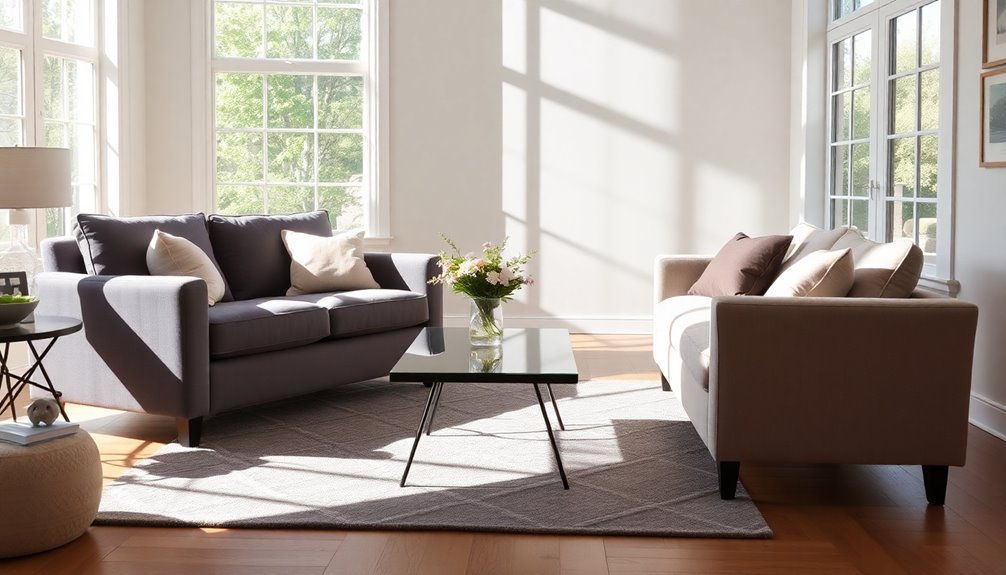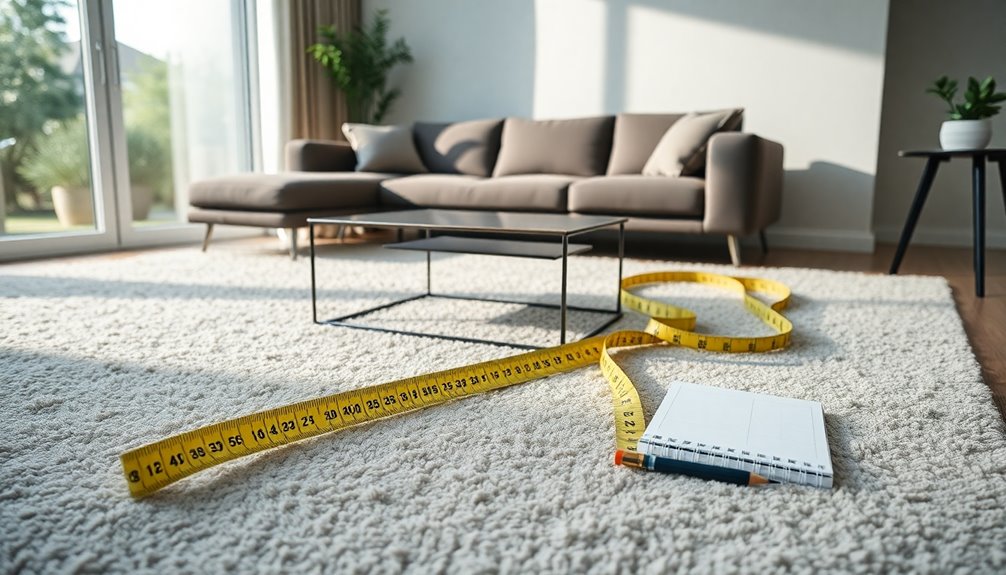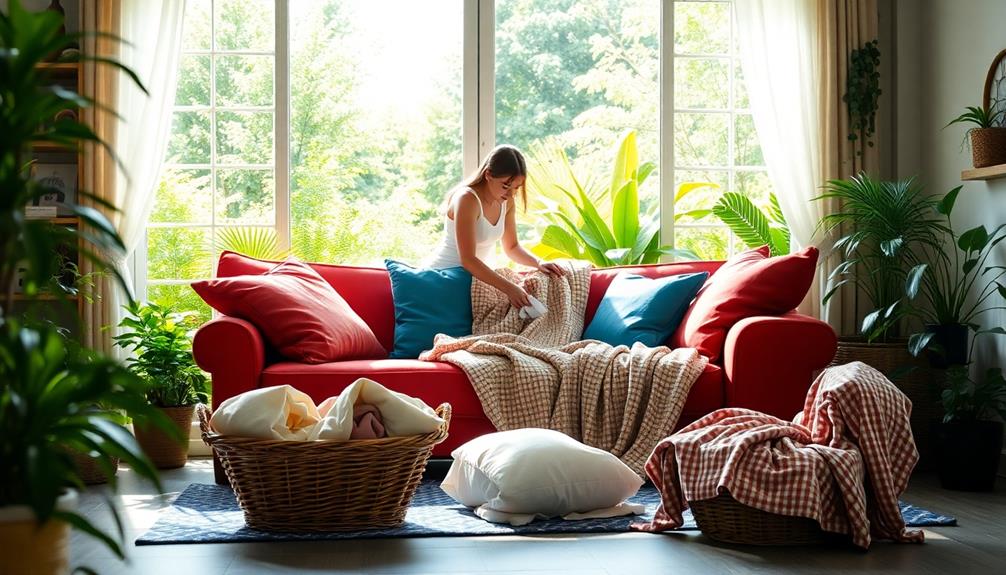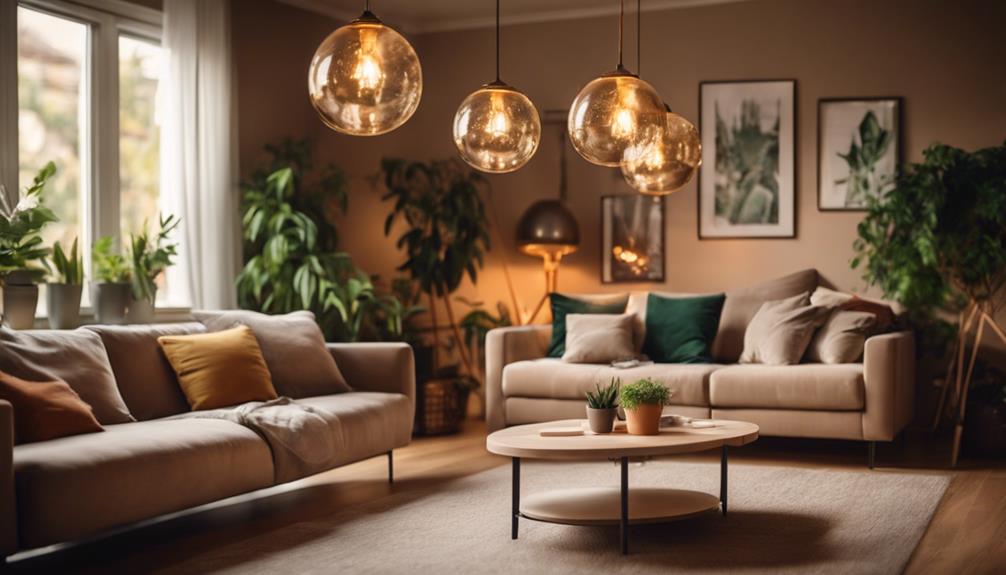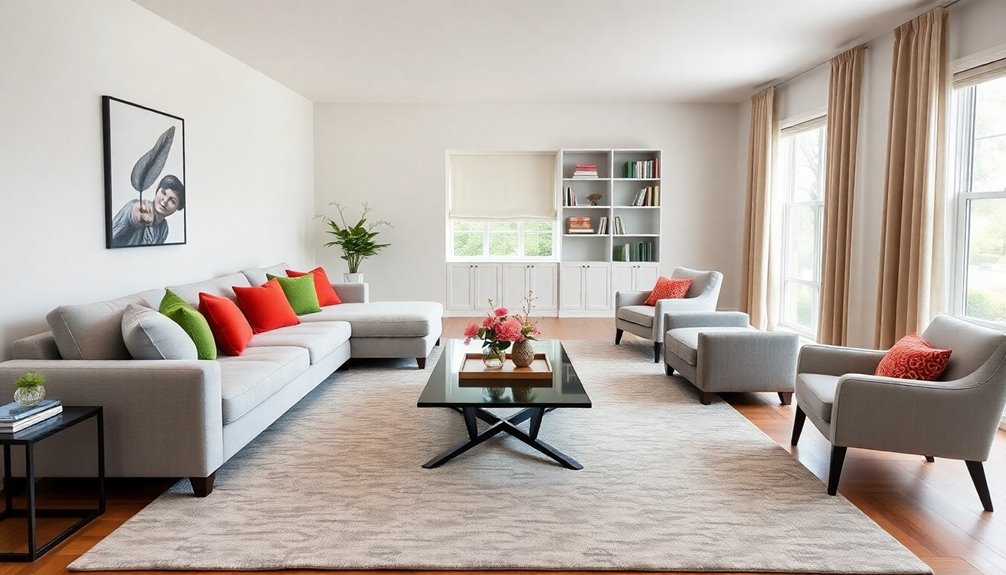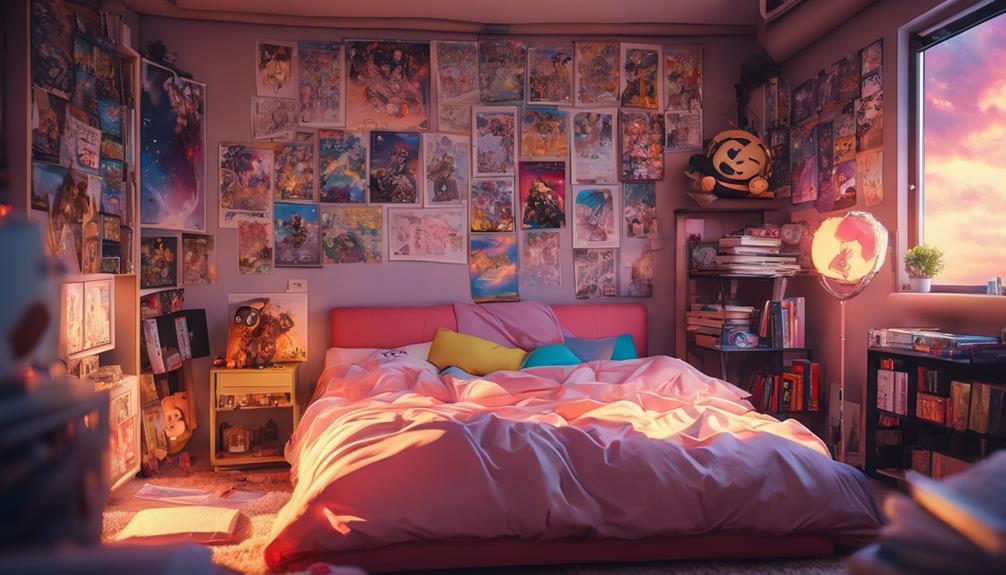To arrange your sofa and loveseat, start by positioning them to face each other, creating an inviting conversation area. Ensure there’s enough space between them for easy movement. Consider adding side tables for function and convenience. Use area rugs to define the space and complement your décor, ensuring the front legs of the furniture rest on the rug. Keep the arrangement balanced by distributing visual weight evenly, mixing styles and colors for interest. With thoughtful placement, your living space will feel harmonious and welcoming. You’ll find more tips to enhance your arrangement and create a cozy atmosphere. Additionally, don’t forget to consider the focal point of the room, whether it’s a fireplace, a piece of artwork, or a television. Arranging sofa and loveseat effectively around this focal point will draw attention and create a cohesive look. Finally, accessorize with cushions and throws to add texture and warmth, inviting you and your guests to relax and enjoy the space.
Key Takeaways
- Position sofas and loveseats facing each other to create an inviting conversation area.
- Ensure there is adequate space for movement between furniture pieces for comfort and accessibility.
- Use side tables between seating to facilitate conversation and provide accessibility to items.
- Incorporate lighting to enhance ambiance and visibility in the seating area.
- Maintain an open layout to encourage flow and make the space feel welcoming.
Introduction
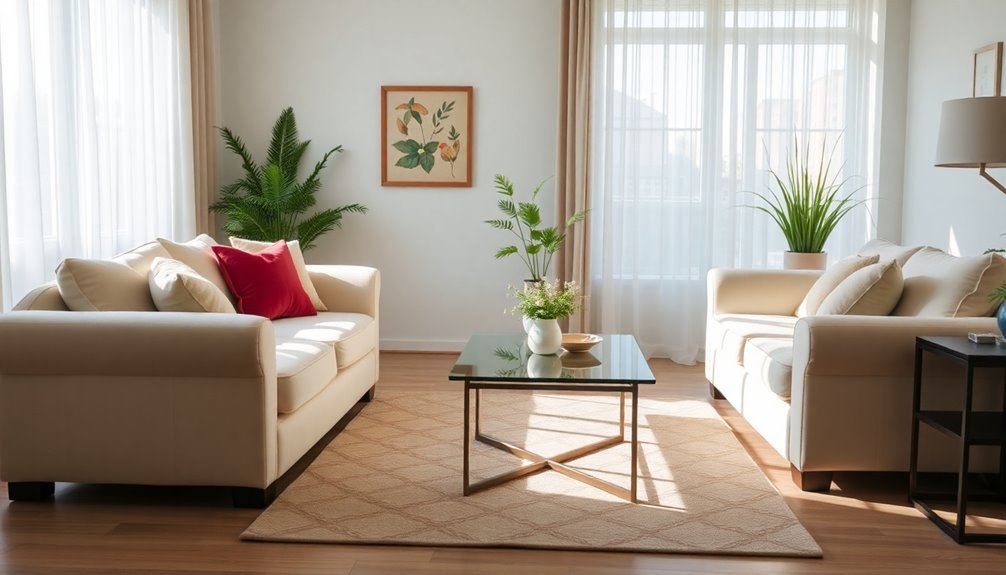
Keeping your sofa and loveseat looking great requires some routine fabric care. You'll want to know specific cleaning techniques for different materials, especially when accidents happen, like a red wine spill. Let's explore how to maintain your furniture so it stays stylish and inviting.
Routine Fabric Care Tips
Maintaining the beauty and longevity of your sofa and loveseat requires a proactive approach to fabric care. Start by regularly vacuuming your furniture with an upholstery attachment to eliminate dust, pet hair, and debris. This helps preserve their appearance and prolongs the fabric's life. When stains occur, spot clean them immediately using a mild detergent and a damp cloth. Always test any cleaning solution on an inconspicuous area first to avoid discoloration.
To ensure even wear, rotate and fluff your cushions frequently. This simple routine fabric care tip can significantly extend the lifespan of your furniture. Additionally, consider applying a fabric protector spray to create a barrier against spills and stains. Remember to reapply it as needed, based on how often you use your sofa and loveseat.
Lastly, always follow the manufacturer's care label instructions for cleaning and maintenance. Different fabrics may require specific techniques or products to avoid damage. By implementing these routine fabric care tips, you can keep your furniture looking great and enhance your overall furniture arrangement.
Fabric-Specific Cleaning Techniques
Understanding the specific cleaning techniques for different fabric types is crucial for preserving the beauty and integrity of your sofa and loveseat. Each upholstery material has unique cleaning methods, so it's essential to know what works best. For instance, microfiber is often cleaned with a mixture of water and mild detergent, while leather requires dedicated leather cleaner and conditioner.
Before you start, always check the manufacturer's care label for recommended cleaning codes. These codes—W for water-based, S for solvent-based, WS for both, and X for vacuum only—guide you in choosing appropriate cleaning solutions. If you encounter stains, blot the area with a clean cloth immediately, avoiding rubbing, which can spread the stain.
Regular maintenance is key to keeping your sofa and loveseat looking fresh. Vacuuming every few weeks helps remove dust and dirt, preventing wear and tear. When deep cleaning upholstery, consider using a steam cleaner that's compatible with your fabric type. This method effectively removes dirt and allergens without harsh chemicals, ensuring your furniture stays in top condition for years to come.
Tackling Red Wine Stains
Everyone dreads the moment a glass of red wine tips over and stains their beautiful sofa or loveseat. The key to effective cleaning is to act quickly. Start by immediately blotting the stain with a clean cloth or paper towel. This helps absorb as much liquid as possible without rubbing, which could spread the stain further.
Next, mix a solution of one part white wine to two parts water and gently apply it to the stain. The acidity in white wine can help neutralize the red pigment. If the stain proves stubborn, create a paste with baking soda and water, applying it directly to the stain and letting it sit for several hours before rinsing.
For those who prefer commercial solutions, opt for stain removers specifically designed for wine stains and follow the manufacturer's instructions for best results.
Before you go all in, remember to test any cleaning solution on a hidden area of your fabric first. This step ensures it won't cause discoloration or damage to your lovely sofa or loveseat. With these tips, you can tackle red wine stains effectively and maintain your furniture's beauty.
Shielding From Sunlight Damage
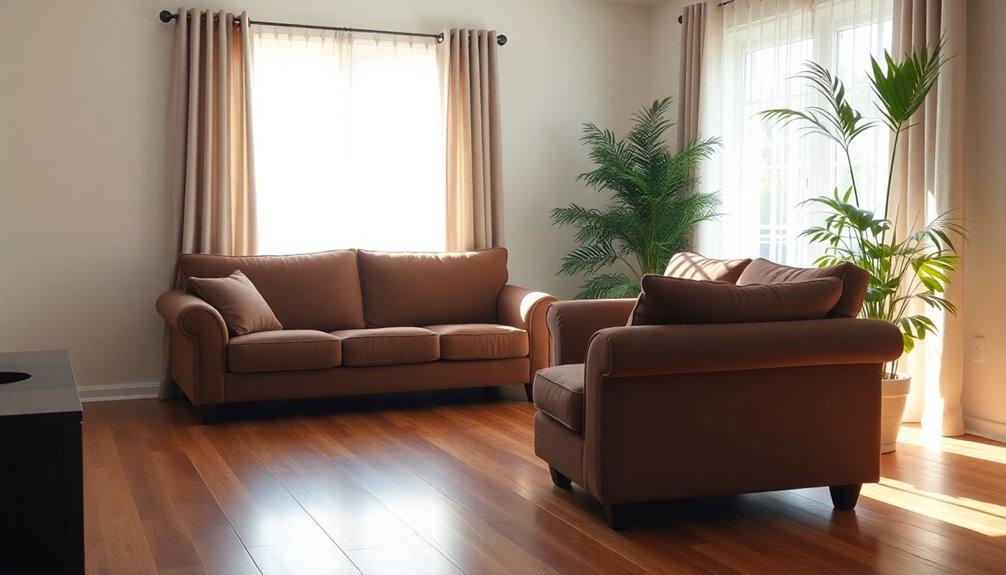
To keep your sofa and loveseat looking fresh, consider using scratch-resistant fabrics that withstand wear and tear. Stylish fabric protectors not only enhance your decor but also shield your furniture from harmful sunlight. Plus, regularly rotating cushions helps maintain even color and texture, ensuring your pieces stay vibrant longer.
Scratch-Resistant Furniture Fabrics
When it comes to stylish and practical living spaces, scratch-resistant furniture fabrics stand out as a smart choice for your sofa and loveseat. With options like microfiber and tightly woven polyester, these materials offer durability against pet claws and everyday wear, ensuring your sofa and loveseat arrangement stays looking fresh.
Additionally, many scratch-resistant fabrics come with a protective coating that shields against sunlight damage. This feature helps prevent fading, maintaining the vibrant colors of your furniture over time. By choosing high-performance materials, such as Sunbrella, you enhance your furniture's resistance to stains and scratches while also keeping it fade-resistant against UV exposure. Moreover, investing in high-efficiency toilets can also benefit your overall home aesthetics by ensuring a cohesive design throughout your living spaces.
Regular cleaning and maintenance can extend the lifespan of these scratch-resistant fabrics. Designed to withstand routine care, they maintain their protective qualities, making them a wise investment. Not only do they reduce the need for frequent replacements or extensive repairs, but they also contribute to a more efficient furniture layout, allowing you to enjoy your living space without constant worry. So, when arranging your sofa and loveseat, consider the benefits of scratch-resistant fabrics for a stylish and resilient setup.
Stylish Fabric Protectors
Stylish fabric protectors are essential for safeguarding your sofas and loveseats from harmful sunlight damage. With the right protectors, you can keep your upholstery looking vibrant and fresh for years. Consider options like slipcovers, window films, and UV-resistant sprays. Fabrics treated with UV protection can cut fading by up to 98%, ensuring your furniture stays as beautiful as the day you brought it home.
To further shield your sofas and loveseats, pair fabric protectors with light-filtering window treatments. This combination can significantly reduce the amount of direct sunlight that hits your furniture. While you're at it, think about how you arrange furniture in your living space. By placing pieces strategically, you can minimize the exposure of your upholstery to sunlight. Additionally, investing in home security systems can provide peace of mind while you focus on decorating your space with the best home security systems.
Investing in high-quality fabric protectors doesn't just offer practical defense against sun damage; it can also enhance the aesthetic appeal of your room. Choose stylish designs that complement your decor while keeping your sofas and loveseats protected. By taking these steps, you'll enjoy a gorgeous, long-lasting living area that remains inviting and comfortable, free from the effects of sunlight fading.
Regularly Rotate Cushions
How can you keep your sofa and loveseat looking fresh and vibrant despite the harsh effects of sunlight? Regularly rotating your cushions is a simple yet effective strategy. By shifting them every few weeks, you'll help prevent uneven fading and wear, especially in areas that get direct sunlight. This rotation ensures that all parts of your cushions get equal usage, maintaining their shape and comfort over time.
When arranging your sofa and loveseat, position them away from direct sunlight whenever possible. This proactive step minimizes sun damage to the upholstery, prolonging its life. You might also consider investing in UV-protective window treatments. These can shield your cushions from harmful rays while enhancing the overall aesthetic of your living space. Additionally, incorporating natural elements into your decor can further create a serene atmosphere that complements your furniture.
Furthermore, using removable cushion covers can protect the inner cushions from dirt and stains, making them easier to clean and maintain. By combining these techniques—rotating your cushions, strategic arranging, and using protective covers—you'll ensure your sofa and loveseat remain vibrant and comfortable for years to come. Taking these small steps can make a big difference in the longevity of your furniture.
Furniture Frame Stability Checks
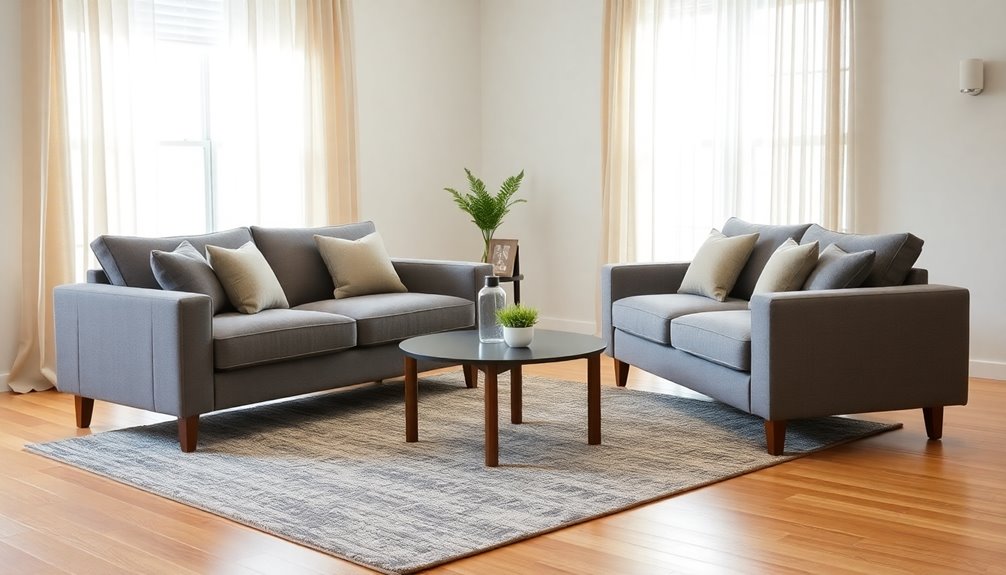
Before you arrange your sofa and loveseat, it's crucial to ensure their frames are stable. Check for any wobbling, inspect joints for damage, and make sure everything is level. Addressing these frame integrity concerns now can save you from issues later on, so let's look at what needs your attention.
Frame Integrity Concerns
Ensuring the frame integrity of your sofa and loveseat is crucial for longevity and safety. When you're furniture arranging, start by checking the materials used in the frame. Solid wood or high-quality plywood offers superior durability compared to particleboard or MDF, which can compromise stability.
Next, inspect joints and connections. Look for reinforcement with dowels, screws, or metal brackets to prevent wobbling or structural failure. You can also test the frame's stability by applying weight evenly across the seating area. Listen for any creaking sounds or noticeable flexing, as these can indicate weaknesses in the frame integrity.
Don't forget to examine the legs of both the sofa and loveseat. Ensure they're made from sturdy materials and securely attached to support the furniture's weight. Regular checks are essential, especially after moving or rearranging your furniture. Identifying potential issues early can prevent compromising the integrity of your sofa and loveseat. By focusing on these aspects, you'll not only enhance the stability of your furniture but also extend its lifespan, ensuring a safe and comfortable seating experience for you and your guests.
Leather Repair Techniques
After you've checked the frame's integrity, it's time to focus on leather repair techniques. First, ensure your furniture's stability by inspecting the joints, screws, and connections of your sofa. If you spot any unevenness, use a level to assess the situation. Reinforce weak areas with brackets or wood glue to enhance stability before diving into leather repairs.
Next, look for signs of wear or damage on the frame, such as cracks or splintering. Address these issues with the appropriate wood filler or reinforcement techniques, preventing further deterioration that could compromise your repair efforts. It's crucial that the legs of your sofa are firmly attached and free from wobbling; if any legs are loose, tighten or replace them to maintain balance during the repair process.
Once you've made the necessary repairs, conduct a final stability check. Gradually apply weight to ensure the frame can support the leather and provide a safe, durable seating solution. By following these steps, you'll not only enhance the appearance of your leather sofa but also ensure it remains stable and functional for years to come.
Cushion Fluffing Techniques
To keep your cushions looking their best, you should regularly fluff them by grabbing each corner and giving them a good shake. This simple action helps maintain their shape and prevents sagging, ensuring your sofa and loveseat remain comfortable and visually appealing.
In addition to fluffing, it's essential to check the stability of your furniture frame. Gently rock your sofa and loveseat; if you notice any creaking or wobbling, it might indicate loose joints that need tightening or repair. Addressing these issues early ensures long-term use and comfort.
Every so often, use a vacuum with an upholstery attachment to remove dust and debris from your cushions. This not only helps maintain their structure but also prolongs the life of the fabric. Don't forget to rotate and flip your cushions periodically to promote even wear and avoid flattening in specific areas over time.
Finally, inspect the zippers and seams of your cushions for signs of damage. Repairing these early can prevent further deterioration and maintain the overall integrity of your furniture, keeping your space looking fresh and inviting.
Personalized Cushion Covers
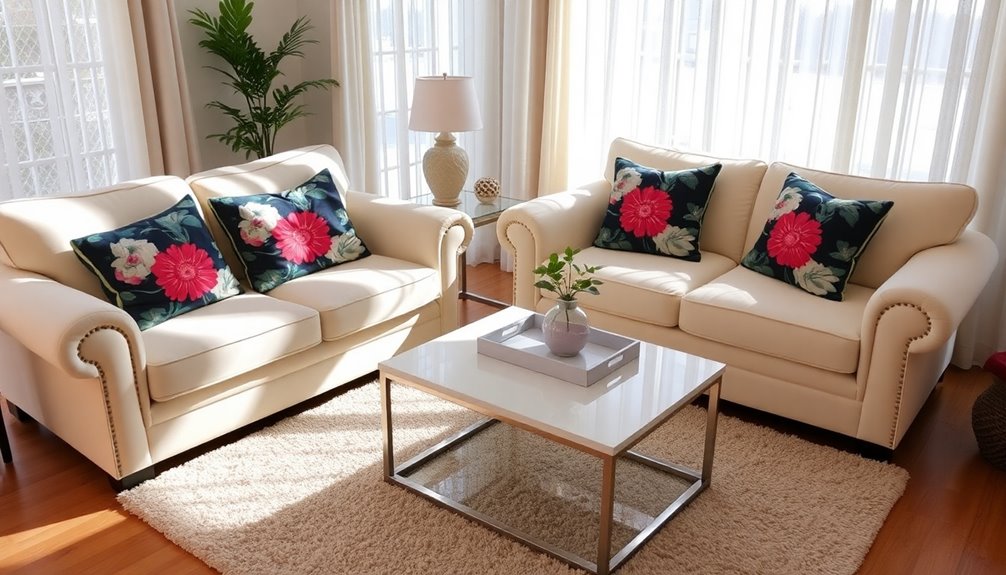
Personalized cushion covers can transform your sofa and loveseat arrangement into a reflection of your unique style. By selecting covers with vibrant colors, you can instantly uplift the ambiance of your living space. Unique patterns not only add visual interest but also help tie together the overall color scheme, making your decor feel cohesive.
Consider customizing your cushion covers with monograms or unique designs. This personal touch can make your seating area feel more inviting and tailored to your preferences. You'll find that opting for different textures, such as plush velvet or breathable linen, can create depth and a cozy atmosphere. Mixing textures adds an element of sophistication and comfort that enhances your sofa and loveseat setup. Additionally, incorporating soft textiles can elevate the overall comfort of your living area.
Regularly changing out your cushion covers based on trends or seasons is a smart, cost-effective way to refresh your living area without undergoing a complete redesign. With the right personalized cushion covers, you can easily express your individuality and keep your space feeling fresh and stylish. So go ahead, explore vibrant colors, unique patterns, and different textures to truly make your sofa and loveseat arrangement your own.
Seasonal Fabric Storage Tips
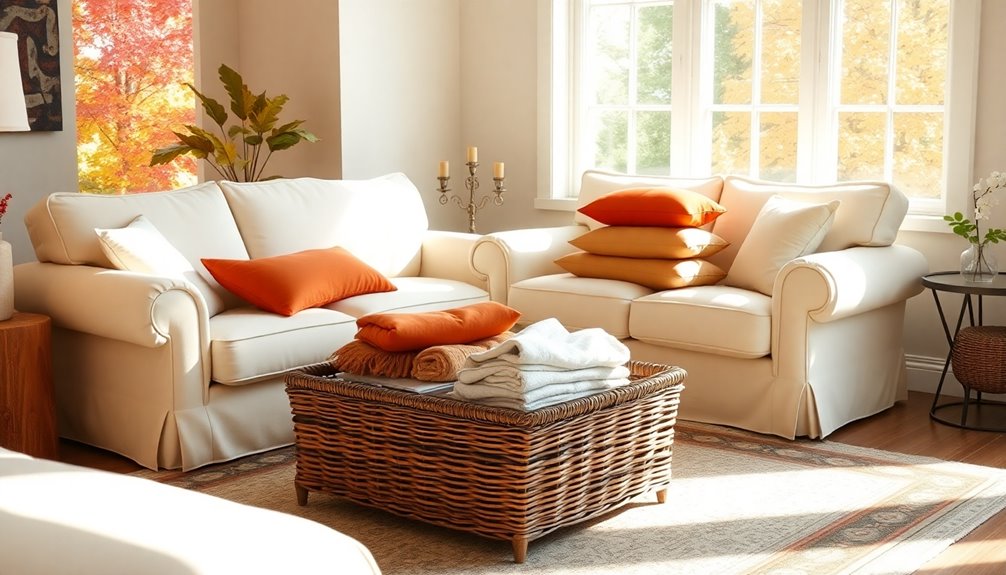
When it comes to storing seasonal fabrics, keeping them in optimal condition is key. To protect your fabrics from dust and moisture, use breathable fabric storage bags or cotton sheets. Avoid placing them in direct sunlight, as this can lead to fading and deterioration. Instead, find a cool, dry place for their storage.
Label your storage containers clearly to make it easy to identify which seasonal fabrics belong to each decor theme. This way, when it's time to change your arrangement, you won't waste time searching for specific items. If space is a concern, consider vacuum-sealing your seasonal fabrics. This method saves space and protects them from pests, ensuring they remain wrinkle-free.
It's also a good habit to rotate your stored fabrics seasonally. Doing so helps maintain freshness and prevents any musty odors from developing during long-term storage. By following these tips, you can ensure that your seasonal fabrics remain in excellent condition, ready to enhance your home's decor when the time comes to bring them out again.
Conclusion
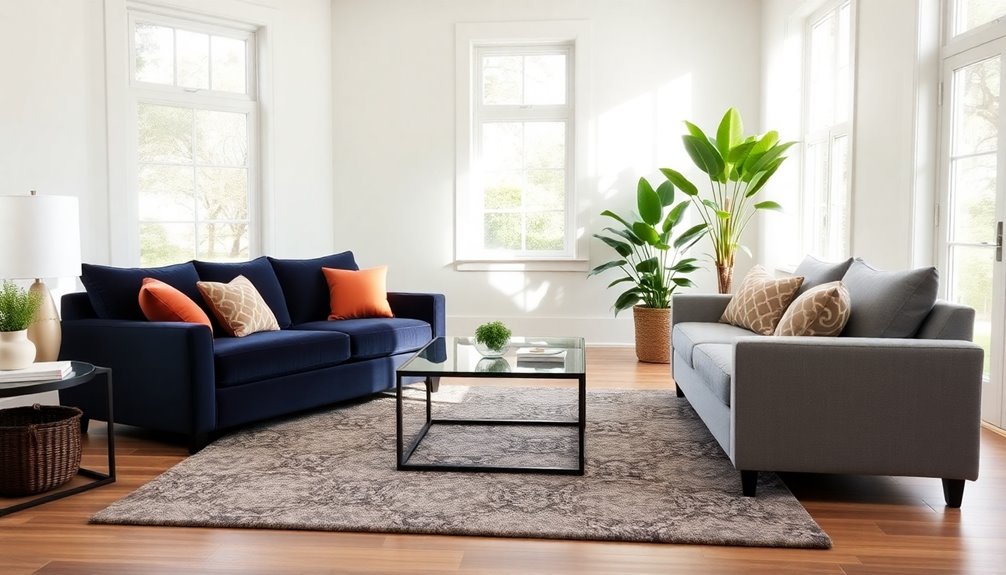
In conclusion, arranging your sofa and loveseat thoughtfully can transform your living space into a welcoming and functional area. Start by considering an L-shape configuration, which encourages conversation and makes the most of your space. Position the sofa and loveseat in relation to a focal point—like a fireplace or television—to enhance the room's functionality and visual appeal.
Ensure there's a minimum of three feet of walkway space between furniture pieces to facilitate movement and maintain comfort. This thoughtful arrangement not only allows for easy access but also keeps the conversation area open and inviting.
Incorporating area rugs can help define the seating area, adding a cohesive look while ensuring that at least the front legs of each piece sit on the rug. Don't hesitate to mix styles and colors of the sofa and loveseat; this adds personality and visual interest to the living space while maintaining balance.
Frequently Asked Questions
What Is the 2 3 Rule Sofa?
The 2-3 Rule for sofas suggests that a sofa should comfortably seat 2-3 people, providing a balanced and inviting atmosphere in your living space. This guideline helps you choose the right size for your furniture, ensuring it complements the room without overcrowding. By following this rule, you create a harmonious setup that encourages conversation, enhances comfort, and boosts the overall aesthetic appeal of your living area. It's all about balance and style!
How to Place a Couch and Loveseat?
When you're placing a couch and loveseat, start by identifying a focal point, like a fireplace or TV. Position them in an L-shape to encourage conversation. Make sure there's at least three feet of space for walkways, ensuring comfort and accessibility. Use an area rug to unify the seating area, and consider contrasting colors or styles to add interest. Finally, add side tables or lamps for extra functionality and balance.
What Are the Four Rules in Furniture Arrangement?
When it comes to furniture arrangement, there are four essential rules to follow. First, orient your pieces around a focal point to encourage conversation. Next, ensure traffic flow by keeping pathways clear. Balance the scale of your furniture to fit the space appropriately. Lastly, arrange seating for easy access to tables. By following these guidelines, you'll create a harmonious and functional living area that suits your needs and style.
Which Direction Should Your Sofa Face?
Your sofa should face the room's focal point, like a fireplace or television, to create an inviting atmosphere. This positioning encourages conversation and makes the space feel more welcoming. If you have a long, narrow room, consider angling the sofa to add visual interest and improve flow. Just remember to leave enough space around it for easy movement, ideally about three feet from other furniture pieces, to keep the area comfortable and accessible.
